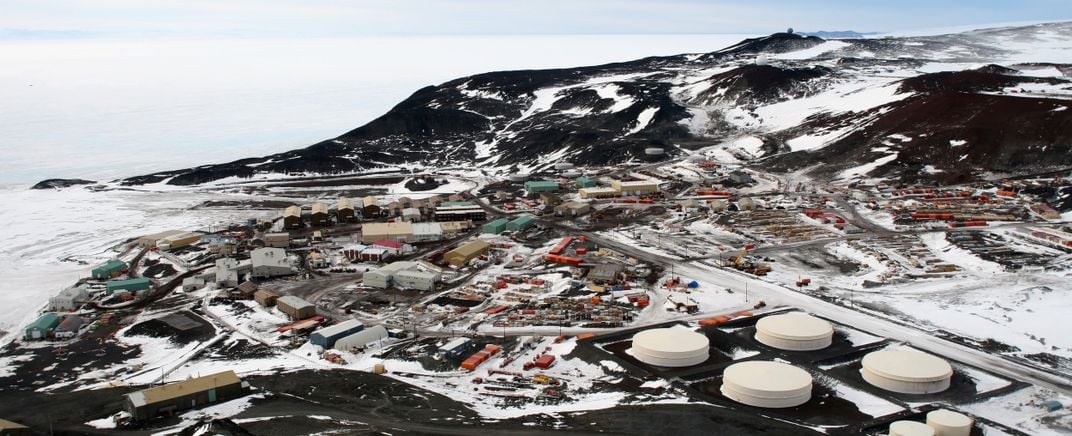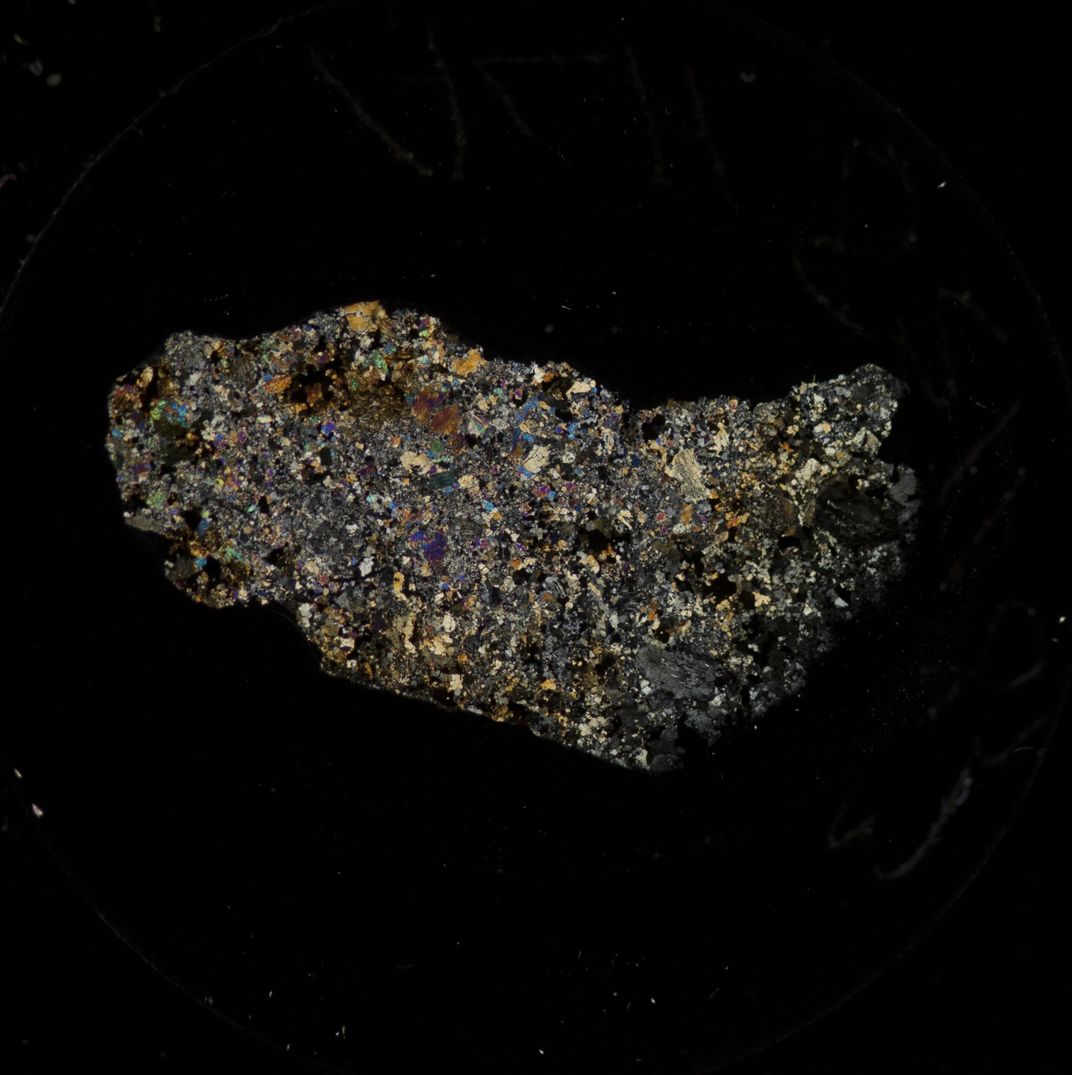NATIONAL MUSEUM OF NATURAL HISTORY
What Antarctic Meteorites Tell Us About Earth’s Origins
Each year, Smithsonian scientists collect hundreds of meteorites from Antarctica that reveal details about the origins of Earth and our solar system.
/https://tf-cmsv2-smithsonianmag-media.s3.amazonaws.com/blogging/featured/A_hand_holds_a_rock_using_tongs..jpg)
In mid-January of 1909, a group of men lugged hundreds of pounds of supplies through fierce Antarctic winds, biting cold and dangerous crevasses for over a thousand miles. Conditions were too harsh for vehicles, so they traveled by foot, determined to locate the Earth’s magnetic South Pole. The band of scientists — including Douglas Mawson and Edgeworth David — were one of many who hunted for the elusive South Pole throughout the decades.
Over a century later, scientific research in Antarctica still poses formidable challenges. But despite its harsh nature and barren appearance, this landscape holds secrets to the origins of our bustling planet through meteorites. Each year, Smithsonian scientists collect hundreds of meteorites from Antarctica that reveal details about the origins of Earth and our solar system.
The Antarctic meteorite program started after Japanese glaciologists working in Antarctica found seven meteorites on the continent in 1969 and realized they were all from different meteors. Seven years later, researchers from Japan and the United States organized a joint mission to look for more. The search soon became an annual event, and after more than 40 years, scientists have accrued more than 23,000 meteorites from the continent. They make up 90-95% of the individual specimens in the National Meteorite Collection, housed and cared for by the Smithsonian’s National Museum of Natural History.
Why Antarctica?
As the coldest, driest place on earth, Antarctica forms a natural freezer that keeps meteorites well-preserved. Once a meteorite freezes into the ice, the movement of glaciers carries it from the pole towards the coast.
“The ice in Antarctica is like a natural conveyor belt,” said Tim McCoy, curator of meteorites at the Smithsonian’s National Museum of Natural History. “And when it hits the Trans-Antarctic Mountains, it tries to go over them. Strong winds blow away the ice, leaving the rocks behind.”
Each November, a handful of scientists head to the plateau just south of the Trans-Antarctic mountains and spend around six weeks picking up meteorites. The researchers don’t face the same struggles of the first Antarctic explorers, but their time is not without hurdles. A quarter to a third of the days prove unsuitable for working due to high-speed winds or overcast lighting that blankets the features of the ground in uniform, flat white.

The team also faces psychological challenges. Antarctica, at times, feels more isolating than space. This prompts some astronauts to join the group as part of their mental training for the International Space Station.
“All the astronauts that have worked with us have said this is just like being on the space station,” said Cari Corrigan, a Smithsonian research geologist who has collected meteorites in Antarctica twice. “Except, on the space station, they have constant contact with mission control. We have one call-in a day to let the base know that we’re ok.”
Over the weeks, the scientists collect hundreds of meteorites that range in size from M&M’s to soccer balls. Most of them are about fist-sized. The first thing scientists look for to determine whether they have a meteorite rather than an Earth rock is a thin, dark coating called a fusion crust.
“When the rock comes through the atmosphere, the outside heats up and starts to melt due to friction,” said Corrigan. “If it doesn’t burn up all the way — which most things do — you end up with fusion crust.”
What do they do with them?

Scientists keep the meteorites frozen after collecting them and ship them from the field to NASA Johnson Space Center in Houston, Texas. Researchers at the space center thaw them and break off a tiny piece to send to the Smithsonian for chemical analysis.
“Eventually, they all come to us,” said Corrigan. “We’re the long-term keepers of the meteorites.” After researchers classify a meteorite, it goes into storage at an offsite building of the museum. To prevent rust, weathering or leaching of minerals, the rocks stay in cases filled with nitrogen gas shared by the Biorepository.
“They use the liquid nitrogen to keep their stuff frozen, and we use the dry nitrogen to keep our meteorites from being exposed to the water and everything else in the atmosphere,” said Corrigan.
Antarctic meteorites haven’t been around organic matter like meteorites that land in other places, so they provide uncontaminated snapshots of the formation of our solar system.
“Our planet has weathering. It has volcanism and plate tectonics that destroy rock,” said McCoy. “The first half-a-billion years of our planet’s history has been wiped out.”
Most meteorites from the asteroid belt date to 4.6 billion years ago. “So, if we want to understand the first half-a-billion years of our solar system’s history, meteorites are the place to go,” he said.
What can meteorites tell us?
Geologists estimate that over 99% of the meteorites in the Antarctic collection came from the asteroid belt, while Lunar and Martian meteorites make up less than 1% of the collection. Most of the rocks are chondrites — a class of non-metallic meteorite made up of small grains called chondrules. Some of these chondrules contain mineral fragments that formed before the solar system.

“They’re called presolar grains, and we think they came from a star that exploded nearby when our solar nebula was just forming,” said Corrigan. One sub-group of chondrites, called carbonaceous chondrites, contain water that scientists think might have created Earth’s oceans.
“We think they come from something called C-type asteroids,” said McCoy. “And we’ve just visited one of those with the NASA OSIRIS REx mission to Benu.” The scientists designed and carried out the multi-year mission in part to look for the types of water-bearing minerals that produced oceans and led to life on Earth.
Other meteorites in the collection are iron cores that researchers use to study how planets form.
“It’s such an interesting question that we have a mission launching in 2022 called Psyche,” said McCoy. “We’re going to visit what we think might be the stripped iron core of an ancient asteroid floating out in space.”
The meteorites in the Antarctic collection inspire and direct these new space missions, as well as help scientists analyze the material that comes back. With each new meteorite collected and studied, scientists answer and ask new questions about the early stages of our solar system.
“The fact that we’re going back to the moon and that we have these rovers on Mars — you can trace a lot of that back to these meteorites that we found in Antarctica,” said McCoy. “This relatively modest program drives a lot of why we’re exploring what we are in the solar system.”
Related stories:
What an Asteroid Could Tell Us About Ancient Earth
How to Identify Rocks and Other Questions From Our Readers

